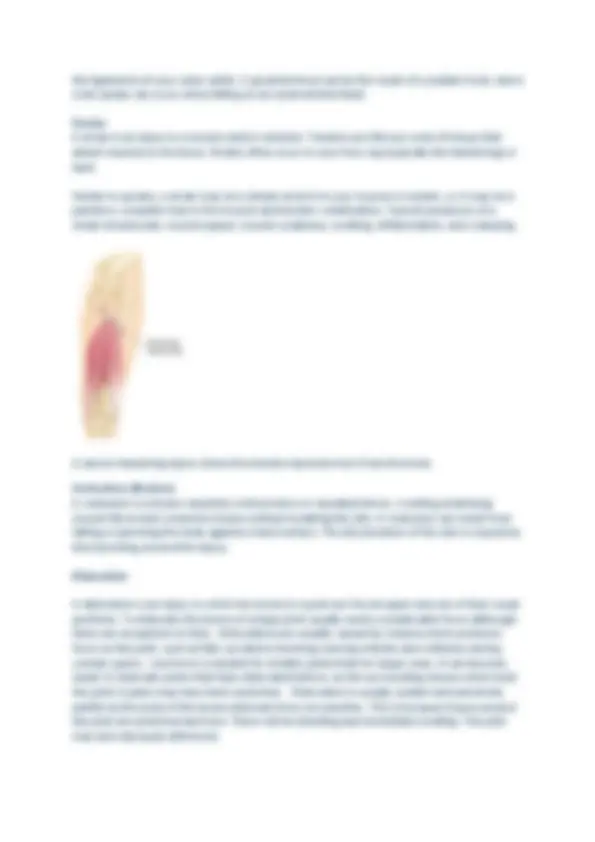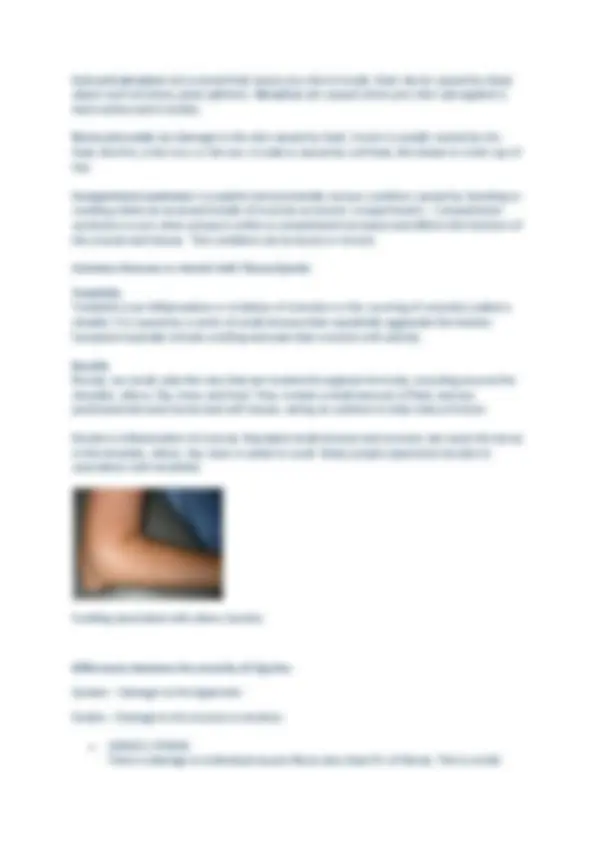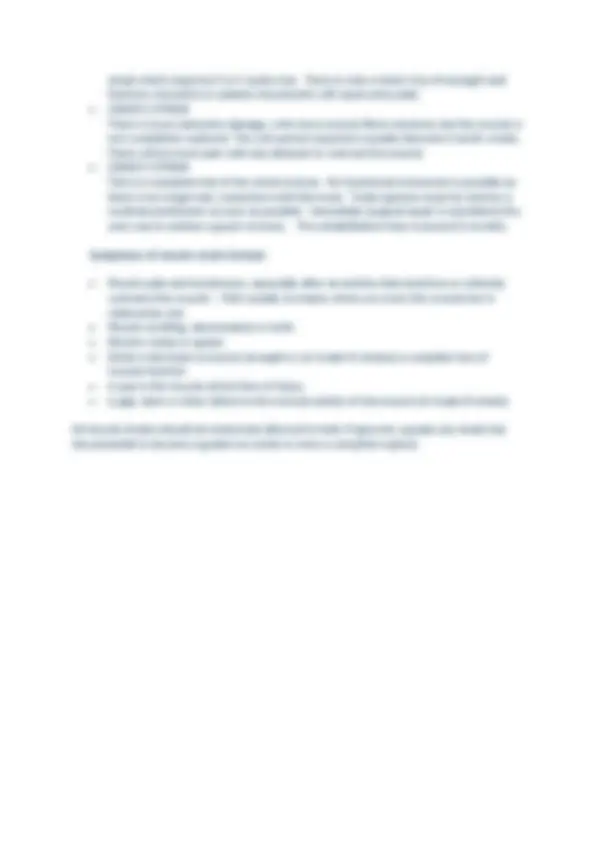





Study with the several resources on Docsity

Earn points by helping other students or get them with a premium plan


Prepare for your exams
Study with the several resources on Docsity

Earn points to download
Earn points by helping other students or get them with a premium plan
Community
Ask the community for help and clear up your study doubts
Discover the best universities in your country according to Docsity users
Free resources
Download our free guides on studying techniques, anxiety management strategies, and thesis advice from Docsity tutors
The common causes and signs of soft tissue injuries, including poor posture, sedentary lifestyle, repetitive behavior, old injuries, body composition, and stress. It also covers the signs and symptoms of soft tissue dysfunction, such as reduced range of motion, postural deformity, muscle weakness, and pain. the difference between acute and overuse injuries and provides examples of common injuries, such as sprains, strains, and contusions.
What you will learn
Typology: Study notes
1 / 5

This page cannot be seen from the preview
Don't miss anything!




•Poor Posture - A very common postural syndrome in modern society involves excessive rearward curving of your lower, middle, and upper back; forward drawn head; rounded shoulders; and excessive forward curving of your upper neck. It is a natural result of prolonged sitting work, especially with computers, I pads and phones.
•In today’s society we are leading a less active lifestyle and spend much more time sitting down, many of us these days work behind a desk and due to all the gadgets and labour saving devices created we also spend much more of our leisure time sitting down. The human body was designed to move and all sorts of problems including weakening of the muscles can occur if we sit for too long.
Signs and Symptoms of soft tissue Dysfunction
Reduced Range of Motion Postural deformity Muscle Weakness and atrophy (wastage) Pain, both local and referred Tenderness on palpation Tension
Trigger points (a sensitive area within the muscle that becomes painful when compressed, it can also refer pain to other areas) Compensation patterns which cause problems in seemingly unrelated areas If a nerve is trapped it can cause numbness, burning or tingling Tissue texture changes Headaches Excessive muscle tension in your neck, chest, shoulders, arms and forearms, back, abdomen, hips, and thighs and legs Strains and trigger points to the above areas Joint dysfunction and sprains in your neck, back, and ribs Increased loading on the intervertebral discs of your spine Impaired function of your breathing muscle (your diaphragm), causing the muscles lifting your upper ribs and shoulders to become overactive and subject to problems
The common causes of soft tissue injury:
Intrinsic – These are factors that affect the body from within and are individual from person to person. Often the cause of injury can be due to lack of physical preparation, overuse, repetition, muscle imbalances, acceleration, deceleration, lack of stretching, postural defects and underlying pathologies
Extrinsic – These are factors that come from outside, external factors. Usually the cause of injury from extrinsic factors includes trauma or impact pressure, friction, environmental factors, equipment, clothing and footwear.
Soft-tissue injuries fall into two basic categories: acute injuries and overuse chronic injuries.
Acute injuries are caused by a sudden trauma, such as a fall, twist, or blow to the body. Examples of an acute injury include sprains, strains, and contusions. Overuse or chronic injuries occur gradually over time, when an athletic or other activity is repeated so often, areas of the body do not have enough time to heal between occurrences. Tendinitis and bursitis are common soft-tissue overuse injuries.
Common acute injuries
Sprains A sprain is a stretch and/or tear of a ligament, a strong band of connective tissue that connects the end of one bone with another. Ligaments stabilize and support the body's joints. For example, ligaments in the knee connect the femur with the tibia, enabling people to walk and run.
The areas of your body that are most vulnerable to sprains are your ankles, knees, and wrists. A sprained ankle can occur when your foot turns inward, placing extreme tension on
Cuts and abrasions are wounds that cause your skin to break. Cuts can be caused by sharp object such as knives, glass splinters. Abrasions are caused when your skin rubs against a hard surface and it breaks.
Burns and scalds are damage to the skin caused by heat. A burn is usually caused by dry heat, like fire, a hot iron, or the sun. A scald is caused by wet heat, like steam or a hot cup of tea.
Compartment syndrome is a painful and potentially serious condition caused by bleeding or swelling within an enclosed bundle of muscles (a muscle 'compartment'). Compartment syndrome occurs when pressure within a compartment increases and affects the function of the muscle and tissues. This condition can be acute or chronic
Common Overuse or chronic Soft-Tissue Injuries
Tendinitis Tendinitis is an inflammation or irritation of a tendon or the covering of a tendon (called a sheath). It is caused by a series of small stresses that repeatedly aggravate the tendon. Symptoms typically include swelling and pain that worsens with activity.
Bursitis Bursae, are small, jelly-like sacs that are located throughout the body, including around the shoulder, elbow, hip, knee, and heel. They contain a small amount of fluid, and are positioned between bones and soft tissues, acting as cushions to help reduce friction.
Bursitis is inflammation of a bursa. Repeated small stresses and overuse can cause the bursa in the shoulder, elbow, hip, knee or ankle to swell. Many people experience bursitis in association with tendinitis.
Swelling associated with elbow bursitis.
Differences between the severity of injuries.
Sprains – Damage to the ligaments
Strains – Damage to the muscle or tendons
GRADE 1 STRAIN There is damage to individual muscle fibres (less than 5% of fibres). This is a mild
strain which requires 2 to 3 weeks rest. There is only a minor loss of strength and function, but active or passive movements will cause some pain. GRADE 2 STRAIN There is more extensive damage, with more muscle fibres involved, but the muscle is not completely ruptured. The rest period required is usually between 3 and 6 weeks. There will be more pain with any attempt to contract the muscle GRADE 3 STRAIN This is a complete tear of the whole muscle. No functional movement is possible as there is no longer any connection with the bone. Total ruptures must be seen by a medical practitioner as soon as possible. Immediate surgical repair is sometimes the only way to achieve a good recovery. The rehabilitation time is around 3 months.
Symptoms of muscle strain include:
Muscle pain and tenderness, especially after an activity that stretches or violently contracts the muscle -- Pain usually increases when you move the muscle but is relieved by rest. Muscle swelling, discoloration or both Muscle cramp or spasm Either a decrease in muscle strength or (in Grade III strains) a complete loss of muscle function A pop in the muscle at the time of injury A gap, dent or other defect in the normal outline of the muscle (in Grade III strain)
All muscle strains should be rested and allowed to heal. If ignored, a grade one strain has the potential to become a grade two strain or even a complete rupture.